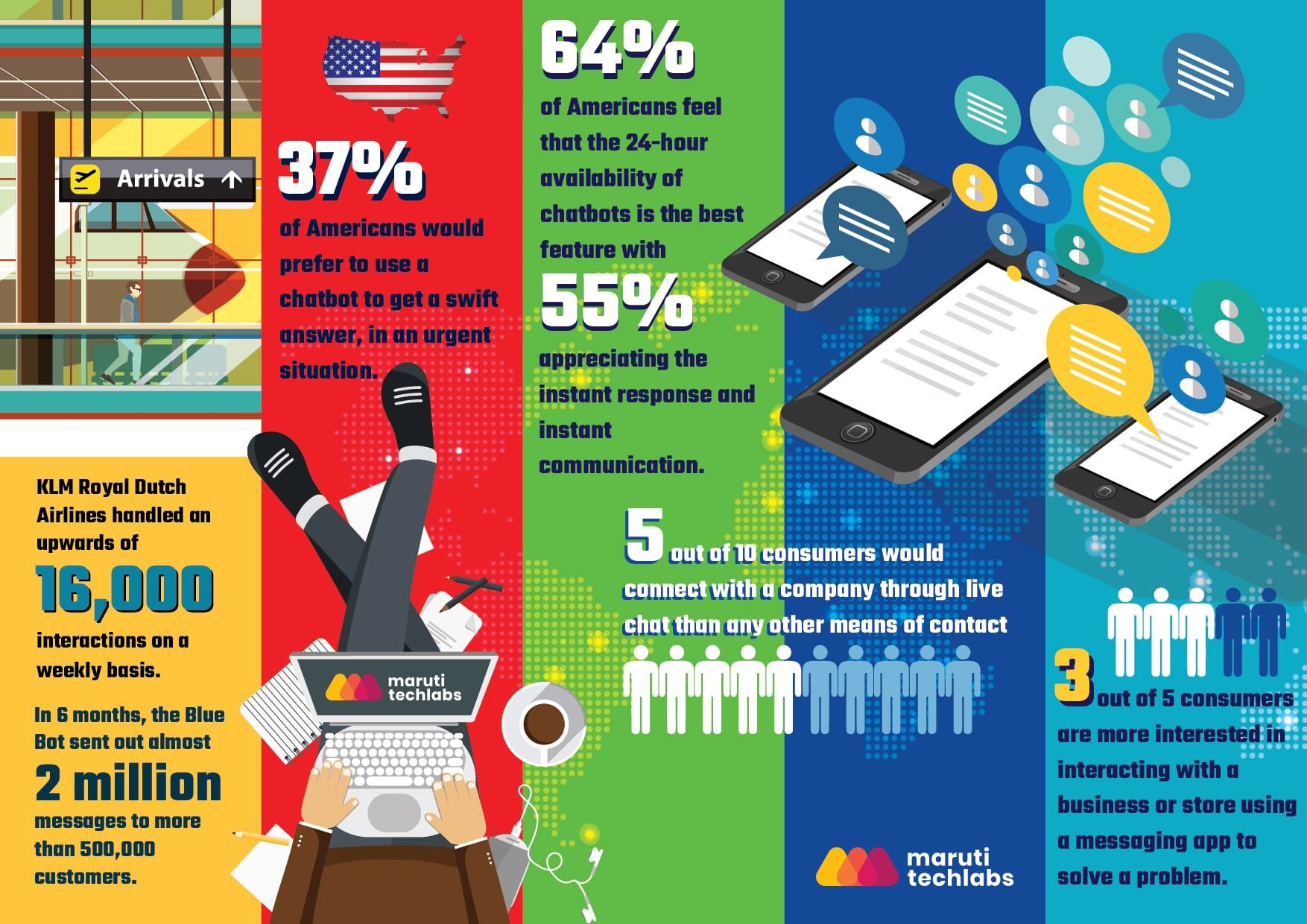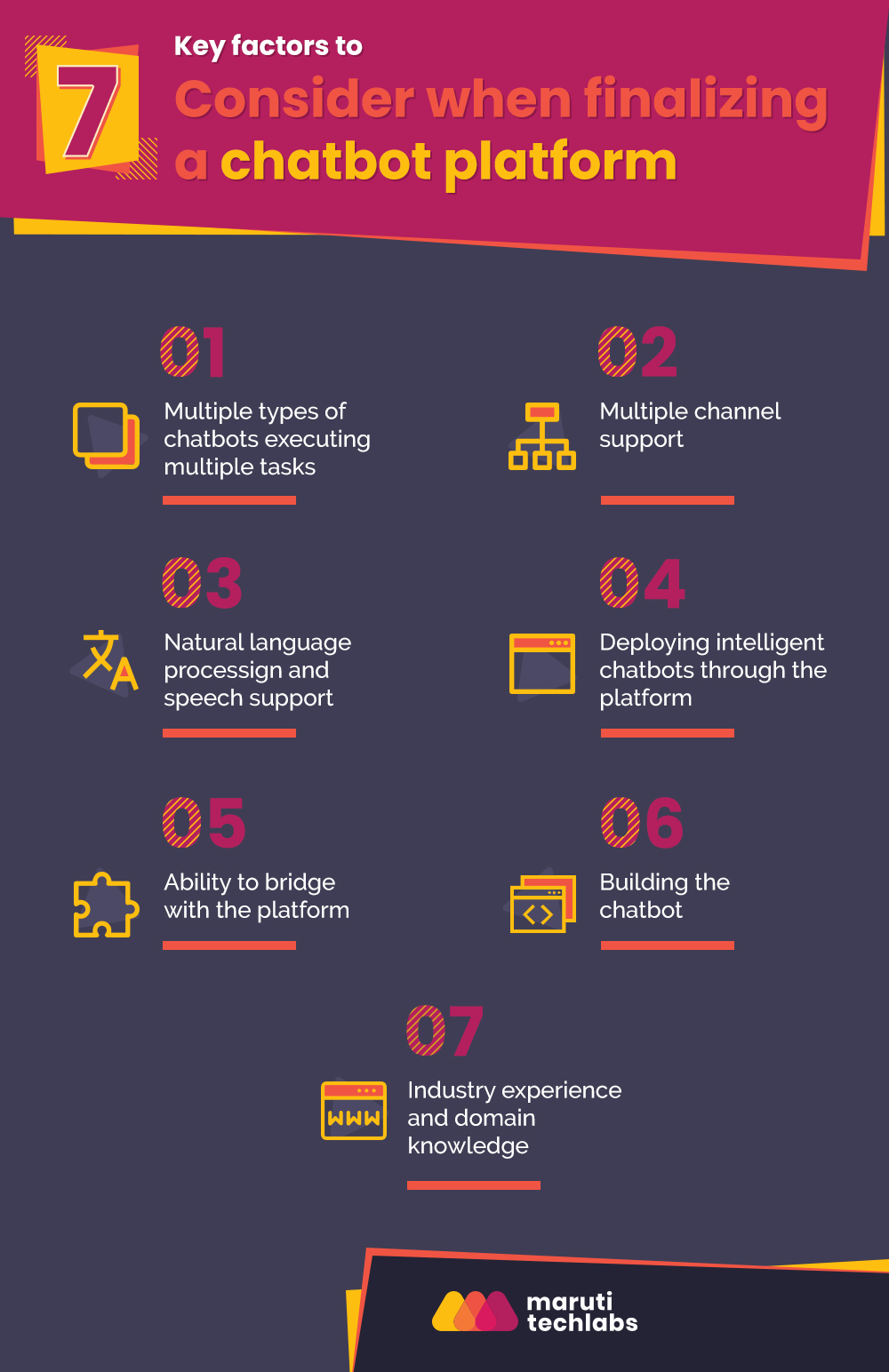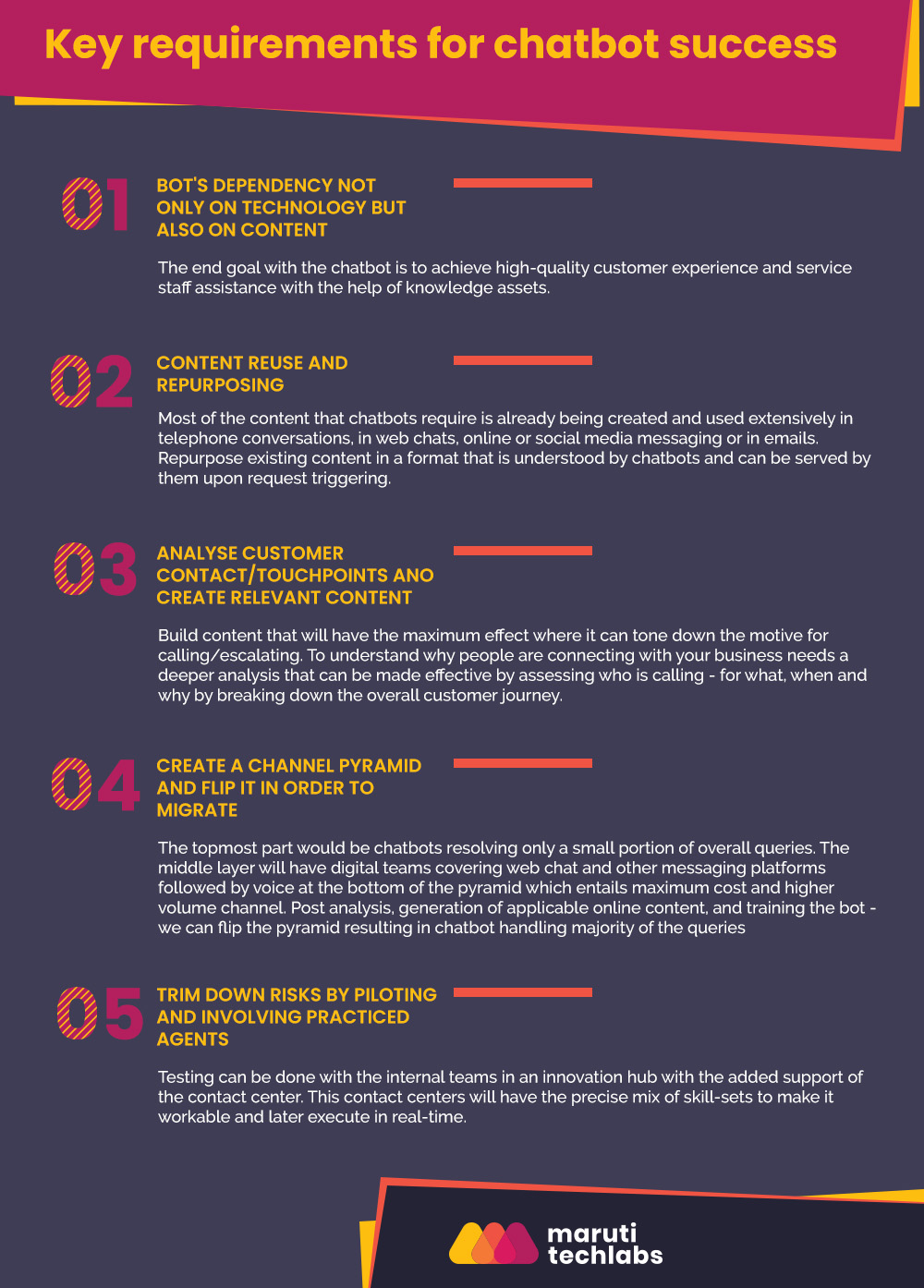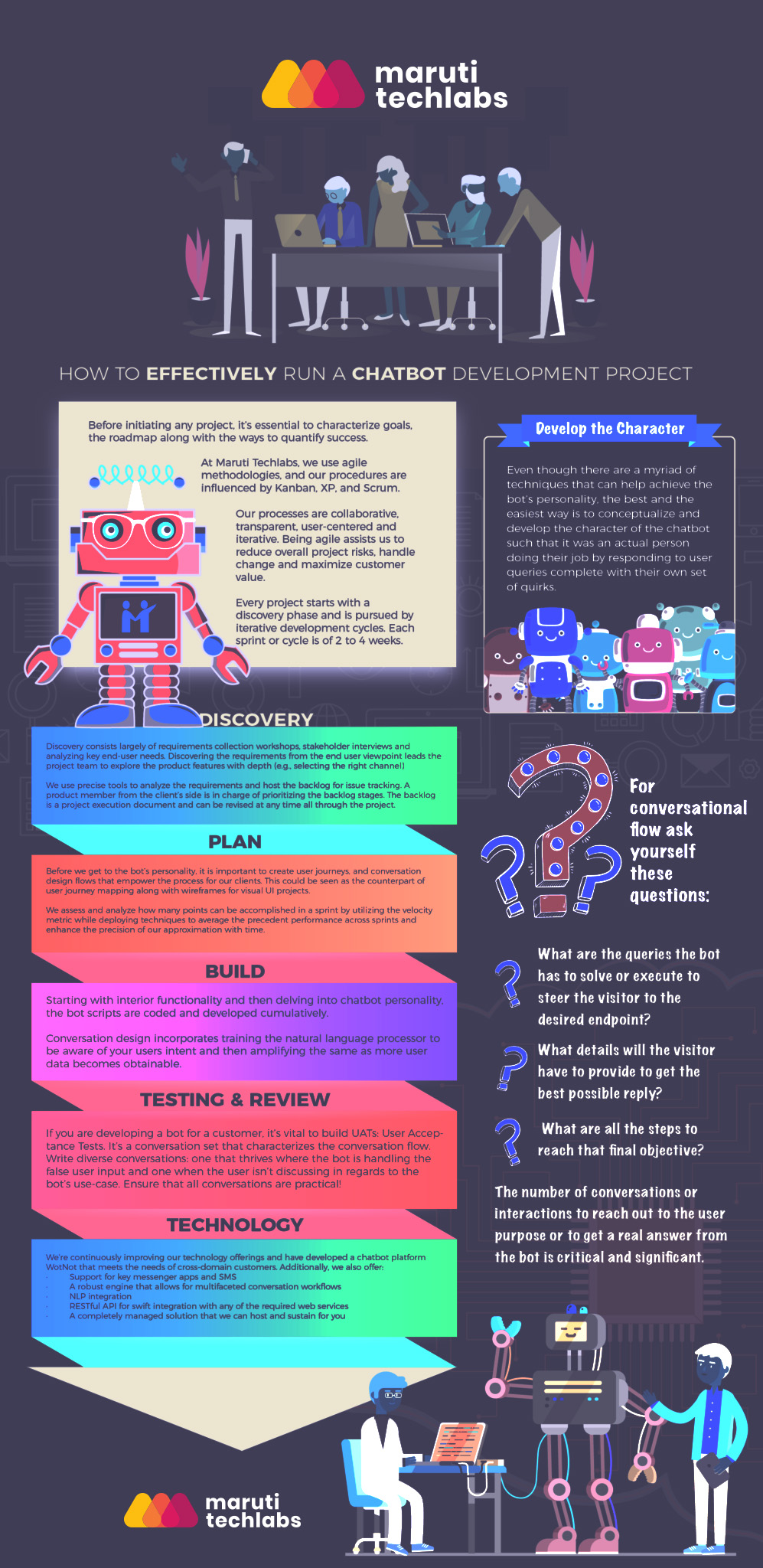

How to plan Chatbot Development at an Enterprise Level?






Chatbots. They’ve been around for quite a while but only recently, (2016 onwards) they’ve became popularized and mainstream, with brands and enterprises engaging in chatbot development in order to reach customers with better efficiency and cost-effectiveness.
Enterprises today, build and deploy chatbots to not only assist but also automate its customer support. For e.g., KLM Royal Dutch Airlines handled an upwards of 16,000 interactions on a weekly basis and in 6 months, the Blue Bot sent out almost 2 million messages to more than 500,000 customers. Talk about scalability.
Surveys show that 37% of Americans would prefer to use a chatbot to get a swift answer, in an urgent situation. Additionally, 64% of Americans feel that the 24-hour availability of chatbots is the best feature with 55% appreciating the instant response and instant communication.

Statistics from HubSpot show that 48% of consumers would connect with a company through live chat than any other means of contact, and 55% of consumers are more interested in interacting with a business or store by using a messaging app to solve a problem.
Additional stats when it comes to business profitability show that 47% of consumers would purchase through a chatbot and millennials (26 to 36-year-olds) are prepared to spend up to £481.15 on a business transaction through a bot.
So far, enterprises that have adopted chatbots have done so by creating and using them in silos. Although this approach may work for businesses that need to automate a handful of tasks, it doesn’t exactly align with the high-end needs of an enterprise – scalability, agility, and cost-effectiveness across a smorgasbord of functions.
When it comes to enterprises, chatbots should be readily available and accessible across a myriad of channels and integrated with internal business systems with Customer Relationship Management (CRM) and Supply Chain Management (SCM) systems being top priority.
When coming up with a bot development strategy, enterprises have several options. A single task bot is not a feasible option for enterprises that need an automated workflow coupled with the integration of internal and external ecosystems and application of natural language processing.
Chatbot frameworks assist programmers with structures with which they can build individual chatbots. However, these frameworks are merely just a collection of a set of tools and services. The frameworks apply to a fixed set of use cases and can be used to assemble and deploy a single-task bot which, at the end of the day, lacks the end-to-end development and ongoing management capabilities.
Frameworks tend to be useful if the use case is small, however, for an enterprise where the overall requirements and scope are more demanding – this is where a chatbot platform comes into the picture.
When it comes to chatbot architecture, these are the following requirements that enterprises should make certain of when it comes to their chatbot development platform –

This functionality is imperative for enterprises as it allows them to track and streamline multiple functions at once. Ideally, the enterprise should have to ability to deploy a chatbot that works on a single task along with creating and deploying a multi-purpose chatbot that communicates with multiple systems and completes a variety of tasks within each of them.
The chatbot development platform should offer pre-built and ready to deploy bots which address certain use cases (e.g., lead generation, customer support etc.) along with the ability to customize them to suit your business needs so as to handle multiple different workflows and processes pertaining to different customer interactions and your business offerings (e.g., a lead generation bot that also answers customer’s queries and replies with answers in a FAQ, document or website).
Enterprises should look for chatbot development platforms where the bots can be deployed to the website, mobile apps, or the channel of its choice with the user interface that is customized for each channel, be it SMS, e-mail or social media. To add on to that, the bots should have the ability to interact with corporate tools like Slack, Telegram, Skype, etc.
Training the chatbot is yet another important consideration when it comes to the scalability of the bot. Does your chatbot development platform incorporate Natural Language Processing (NLP) training? Can the bots maintain accurate interactions and conversations using text and/or speech? A chatbot platform that provides NLP and speech support tends to provide the best results when it comes to understanding user intent and replying with relevant content post-assessment.
The platform should have intelligent chatbots that understand, recollect and continuously learn from data and information that is garnered from each customer interaction. This also includes the need to maintain the context of a customer request during interaction and using Machine Learning to develop further and perfect its natural language processing capabilities.
Does the platform have the ability to share messages between users, bots, and cross-functional systems? This would include sharing messages that are stored between users, bots, and systems whole automatically logging as well as success and failure categorization of messages. This provides a comprehensive and crystal-clear picture of the functionality of the chatbot development platform and subsequently, the bot.
The platform should have an intuitive, web-based tool for designing, building and customizing the chatbot based on bot’s use-cases, tasks and the channels where it is deployed. It should also have the option to restart the process of developing the bot from scratch or reuse developed components along with testing the chatbot build throughout the development cycle.
Identify and engage with the right technology and platform providers that have considerable industry experience and domain knowledge.
Enterprises need to factor in and truly determine what chatbot development platform or relevant framework will augment and facilitate speed, scalability, and flexibility in order to support their customers and employees.

The end goal with the chatbot is to achieve high-quality customer experience and service staff assistance. The noticeable element of chatbots is obviously the technology. However, content plays an important part in its success as well. Creating knowledge assets is a noteworthy investment, but in the shadow of high-end technology components like Artificial Intelligence (AI), the important role of content creation and curation often gets overshadowed.
Most of the content that chatbots require is already being created and used extensively by customer service teams, be it in telephone conversations, in web chats, online or social media messaging or in emails. Repurposing this existing content is in a format that is understood by chatbots and can be served by them upon request triggering.
The goal should be to generate the content once and reuse after that. Accomplishing this needs close links between whoever is curating the content which can be your service teams and the digital marketing department.
The commencing point is to build content that will have the maximum effect – where content can tone down the motive for calling, and the volume of calls is higher. To understand why people are connecting with your business needs a deeper analysis that can be made effective by assessing who is calling – for what, when and why, breaking down the overall customer journey, testing of contacts across channels and research activities like customer surveys, online as well as offline conversations and e-mail content.
While creating a channel pyramid, at the topmost part would be the chatbots. In the beginning, these would resolve only a small portion of overall queries, acting as a preliminary step or an online IVR and directing customers to the digital teams who are more suitable to manage the interactions.
The digital teams will cover web chat and messaging platforms as the center layer, assisting the migration to the digital conversation which is lower in cost as compared to voice at the absolute bottom of the pyramid which entails maximum cost and higher volume channel.
Using all the analysis carried out and the generation of applicable online content, we can then flip the pyramid with chatbots dealing with more and more complex queries – final objective being that they will manage the majority of the cases shortly.
Chatbots are not readily developed technology tools, so the risk of a deprived experience is something one must take into consideration. A few forms of AI can be tested with the internal teams rather than direct exposure to the customers or prospects. It would be prudent to locate these trials in an innovation hub with the added support of the contact center. This contact centers will have the precise mix of skill-sets to make it workable and later try in real-time.
Before initiating any project, it’s essential to characterize goals, the roadmap along with the ways to quantify success.
At Maruti Techlabs, being a chatbot development company, we use agile methodologies, and our procedures are influenced by Kanban, XP, and Scrum. We customize our processes for the different projects and customers that we work with.
Our processes are collaborative, transparent, user-centered and iterative. Being agile assists us to reduce overall project risks, handle change and maximize customer value.
Every project starts with a discovery phase and is pursued by iterative development cycles. Each sprint or cycle is of 2 to 4 weeks.
The discovery phase is undertaken at the commencement of the chatbot development project. It consists largely of requirements collection workshops, stakeholder interviews and analyzing key end-user needs. The backlog is the prime output of this phase with recognized requirements written as ‘user stories’. Identifying the use-case and type they’re looking for (sequential bot or NLP based) helps in listing out the various intents and actions that are to be carried out the chatbot. Discovering the requirements from the end user viewpoint leads the project team to explore the product features with depth.
For example, selecting the precise messaging platform (Facebook Messenger, Slack or your Website) is the key point of the discovery phase. Ultimately the preference should be focused as per your target audience, and you need to meet them where they are.
We use precise tools to analyze the requirements and host the backlog for issue tracking. A product member from the client’s side is in charge of prioritizing the backlog stages. The backlog is a project execution document and can be revised at any time all through the project.
Before we get to the bot’s personality, it is important to create user journeys, and conversation design flows that empower the process for our clients. This could be seen as the counterpart of user journey mapping along with wireframes for visual UI projects.
For conversational flow ask yourself these questions:
The number of conversations or interactions required in order to reach out and satisfy the user’s purpose is critical and significant. Even though there are a myriad of techniques that can help achieve the bot’s personality, the best and the easiest way is to conceptualize and develop the character of the AI chatbot such that it was an actual person doing their job by responding to user queries complete with their own set of quirks.
Coming back to the sprint, at the opening of every sprint, we conduct a ‘Sprint Planning’ session. The entire team attends the Sprint Planning meeting, and it is where we go through the utmost priority stories in the backlog, state them in detail, plan the tasks and assess them. Every user story is given an approval criteria to be considered as completed.
We assess and analyze how many points can be accomplished in a sprint by utilizing the velocity metric while deploying techniques to average the precedent performance across sprints and enhance the precision of our approximation with time.

We intend to build and deliver a working product which is ready to use by actual users. The thought is to then iterate on this product, accumulating more features until we start off to meet the objectives we set out right at the initial stages.
Starting with interior functionality and then delving into chatbot personality, the bot scripts are coded and developed cumulatively.
Conversation design incorporates training the natural language processor to be aware of your users intent and then amplifying the same as more user data becomes obtainable.
If you are developing a bot for a customer, it’s vital to build UATs: User Acceptance Tests. It’s a conversation set that characterizes the conversation flow. Write diverse conversations: one that thrives where the bot is handling the false user input and one when the user isn’t discussing in regards to the bot’s use-case. Ensure that all conversations are practical!
At the end of every sprint, we conduct a demo. We run across all the created user stories and try to display its implemented process. The product owner who is from the client’s team reviews and decides whether to allow the implementation on the basis of the determined criteria.
If the user story is 100% accepted, it is given the status as done.
We’re continuously improving our technology offerings and have developed a chatbot platform that meets the needs of cross-domain customers. Additionally, we also offer:
Chatbots are not exactly different from other applications; you have multiple integrations that back the application, with the involvement of all the diverse dynamics. Given that a chatbot is needed to engage rapidly with an end-user, it requires being clear whether the information offered by the different integrations, are critical for the conversation or can be deferred until a later moment. Consistency in the integrations through APIs not only assists the agility but also helps in creating perfect conversations.
Customers today are more insistent than ever, with higher expectations and lower tolerance. A chatbot solution can assist you in meeting those expectations, however, every enterprise doesn’t have the time or resources to come up with a solution that is tailored to their core business – trained and deployable in just a couple weeks time.
At Maruti Techlabs, we offer end-to-end chatbot development services and assist enterprises & brands in streamlining the way they interact with customers. We deploy highly intelligent, sophisticated and scalable chatbot solutions across multiple domains such as Finance, E-Commerce, Real Estate and Insurance to name a few.
Being well-versed in AI, NLP and ML, we provide bot solutions, customized to your requirements, across multiple different channels (Facebook, Twitter, Slack, Telegram, Website or your enterprise’s Intranet). Get in touch with us today to deploy bots that fit your business specific needs while matching your brand’s voice and tone.


